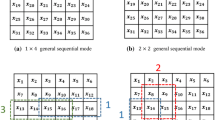Abstract
Improved Pixel-Value-Ordering (I-PVO) based reversible data hiding scheme provides high-fidelity watermarked images with high data embedding capacity. In this paper, a new reversible data hiding scheme based on the I-PVO method is proposed to increase the data embedding capacity. The proposed scheme first divides the cover image into non-overlapping blocks of size 2 × 2 pixels uniformly, and then increases and decreases the values of highest and lowest pixels by one respectively. The proposed modification rules are used to reserve two bins which are used to increase the data hiding capacity. The pixels are sorted in ascending order to calculate two differences in the block. The difference values are calculated by considering pixel values along with their locations in the original block and are utilized to embed secret data in the highest and lowest pixel values using the proposed modification rules. While embedding the secret data, the pixel values are either increased/decreased or left unchanged according to the embedding bits. Thus, the proposed scheme embeds three bits per block in the cover image instead of two bits in the case of I-PVO on average. The experimental results show that the proposed scheme provides significantly higher data hiding capacity than the previous works.






Similar content being viewed by others
Data availability
No data were used to support this study.
References
Alattar AM (2004) Reversible watermark using the difference expansion of a generalized integer transform. IEEE Trans Image Process 13(8):1147–1156
He W, Zhou K, Cai J, Wang L, Xiong G (2017) Reversible data hiding using multi-pass pixel value ordering and prediction-error expansion. J Vis Commun Image R 49:351–360
He W, Xiong G, Weng S, Cai Z, Wang Y (2018) Reversible data hiding using multi-pass pixel-value-ordering and pairwise prediction-error expansion. Inf Sci 467:784–799
Jung KH (2017) A high-capacity reversible data hiding scheme based on sorting and prediction in digital images. Multimed Tools Appl 76(11):13127–13137
Kumar R, Chand S (2017) A novel high capacity reversible data hiding scheme based on pixel intensity segmentation. Multimed Tools Appl 76(1):979–996
Kumar N, Kasana SS (2018) High-capacity reversible data hiding using modified pixel value ordering approach. Journal of Circuits, Systems, and Computers 27(11):175–185
Kumar R, Chand S, Singh S (2018) A reversible high capacity data hiding scheme using combinatorial strategy. International Journal of Multimedia Intelligence and Security 3(2):146–161
Kumar R, Kim DS, Lim SH, Jung KH (2019) High-Fidelity reversible data hiding using block extension strategy. In: 2019 34th international technical conference on circuits/systems, computers and communications (ITC-CSCC). IEEE, JeJu, Korea (South), pp 1–4
Li XL, Li J, Li B, Yang B (2013) High-fidelity reversible data hiding scheme based on pixel–value-ordering and prediction–error expansion. Signal Process 93(1):198–205
Lu TC, Tseng CY, Huang SW, Vo TN (2018) Pixel-value-ordering based reversible information hiding scheme with self-adaptive threshold strategy. Symmetry 10(12):764–791
Malik A, Singh S, Kumar R (2018) Recovery based high capacity reversible data hiding scheme using even-odd embedding. Multimed Tools Appl 77(12):15803–15827
Ou B, Li X, Zhao Y, Ni R (2014) Reversible data hiding using invariant pixel-value-ordering and prediction-error expansion. Signal Process Image Commun 29(7):760–772
Ou B, Li X, Wang J (2016) High-fidelity reversible data hiding based on pixel-value-ordering and pairwise prediction-error expansion. J Vis Commun Image R 39:12–23
Peng F, Li XL, Yang B (2014) Improved PVO-based reversible data hiding. Digital Signal Processing 25:255–265
Qu X, Kim HJ (2015) Pixel-based pixel value ordering predictor for high-fidelity reversible data hiding. Signal Process 111:249–260. https://doi.org/10.1016/j.sigpro.2015.01.002
Thodi DM, Rodriguez JJ (2007) Expansion embedding techniques for reversible watermarking. IEEE Trans Image Process 16(3):721–730
Tian J (2003) Reversible data embedding using a difference expansion. IEEE Trans. Circuits Syst. Video Technol. 13(8):890–896
Wang X, Ding J, Pei Q (2015) A novel reversible image data hiding scheme based on pixel value ordering and dynamic pixel block partition. Inf Sci 310:16–35
Weng S, Zhao Y, Pan JS, Ni R (2008) Reversible watermarking based on invariability and adjustment on pixel pairs. IEEE Signal Processing Letters 15:721–724
Weng S, Pan JS, Jiehang D, Zhou Z (2018) Pairwise IPVO based reversible data hiding. Multimed Tools Appl 77(11):13419–13444
Weng S, Pan JS, Jiehang D, Zhou Z (2018) Pairwise IPVO based reversible data hiding. Multimed Tools Appl 77(11):13419–13444
Wu H, Li X, Zhao Y, Ni R (2019) Improved reversible data hiding based on PVO and adaptive pairwise embedding. J Real-Time Image Proc 16(3):685–695
Wu H, Li X, Zhao Y, Ni R (2020) Improved PPVO-based high-fidelity reversible data hiding. Signal Process 167:107264. https://doi.org/10.1016/j.sigpro.2019.107264
Xiang H, Yuan J, Hou S (2016) Hybrid predictor and field-biased context pixel selection based on PPVO. Math Probl Eng 2016:1–16. https://doi.org/10.1155/2016/2585983
Zhao W, Yang B, Gong S (2018) A higher efficient reversible data hiding scheme based on pixel value ordering. Journal of Information Hiding and Multimedia Signal Processing 9(4):918–928
Acknowledgements
This research was supported by Basic Science Research Program through the National Research Foundation of Korea(NRF) funded by the Ministry of Education(NRF-2018R1D1A1A09081842) and Korea Research Fellowship Program through the National Research Foundation of Korea(NRF) funded by the Ministry of Science and ICT(2019H1D3A1A01101687)
Author information
Authors and Affiliations
Corresponding author
Ethics declarations
Conflict of interest
Authors declare that they has no conflict of interest.
Additional information
Publisher’s note
Springer Nature remains neutral with regard to jurisdictional claims in published maps and institutional affiliations.
Rights and permissions
About this article
Cite this article
Kumar, R., Kumar, N. & Jung, KH. I-PVO based high capacity reversible data hiding using bin reservation strategy. Multimed Tools Appl 79, 22635–22651 (2020). https://doi.org/10.1007/s11042-020-09069-0
Received:
Revised:
Accepted:
Published:
Issue Date:
DOI: https://doi.org/10.1007/s11042-020-09069-0




